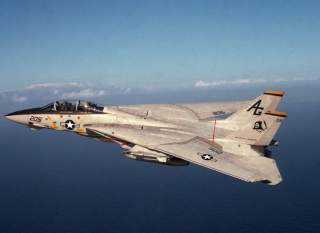Study This Image: In 1991 a Damaged Tomcat Made an Emergency Landing on the USS Eisenhower
Did they make it?
Forward visibility was restricted to looking through a three inch hole in the left windscreen since the rest of the forward glass was so badly cracked.
Taken on Nov. 13, 1991 the pictures in this post show U.S. Navy Grumman F-14B Tomcat (BuNo 161433) from Fighter Squadron 142 (VF-142) “Ghost Riders” aboard the aircraft carrier USS Dwight D. Eisenhower (CVN-69). The crew, LtCdr. Joe F. Edwards Lt.JG Scott C. Grundmeier, had to make an emergency landing when the nose cone came off because because of a latching mechanism failure at a height of 8,200 m over the Persian Gulf.
According to the site HOME OF M.A.T.S., during the departure the radome came in contact with the canopy and broke out the forward glass and shattered the windscreen. The pilot suffered a broken right collarbone and glass in both eyes, but managed to bring the jet back to the ship for a perfect two wire landing.
Forward visibility was restricted to looking through a three inch hole in the left windscreen since the rest of the forward glass was so badly cracked. The pilot was LCDR Joe Edwards and the RIO was LCDR Scott Grundmeier. LCDR Edwards was medevac’d to Bahrain for eye surgery then home to the US. He later became a pilot for NASA in the Space Shuttle program. Both crew members received Distinguished Flying Crosses for their remarkable achievement.
VF-142 was assigned to Carrier Air Wing 7 (CVW-7) abaord the Eisenhower for a deployment to the Mediterranean Sea from Sep. 26, 1991 to Apr. 2, 1992.
The F-14B 161433 was returned to service and finally retired on Mar. 11, 2005.
This article by Dario Leone originally appeared on The Aviation Geek Club in 2018.
Image: Wikimedia

